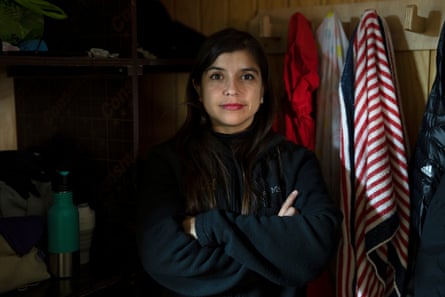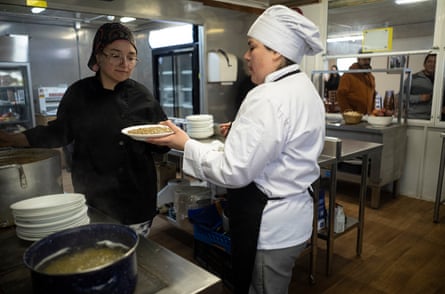For almost as long as the continent has been known of, Antarctica, a wild, white expanse of ice shelves, glaciers and mountainous ridges at the foot of the globe, has been the domain of men.
But images in the popular imagination of bearded men boldly heading into snowstorms could slowly be fading into the whiteness.
Today, women lead expeditions and research stations, make up large parts of support teams on the continent, and are active in leading policy conversations.
Reports uncovering sexual harassment and assault in overwhelmingly male environments, combined with a drive to recognise women’s contributions and efforts to overcome barriers to entry have all contributed to a gradual cultural change.
“We need to decide what kind of a future we want to see for Antarctica, and which people we want making decisions about that future,” said Dr Hanne Nielsen, a lecturer in Antarctic law and governance at the University of Tasmania.
“Then we can decide how we make sure that those people have – and retain – a seat at the table.”
Antarctica was first sighted in January 1820 by a Russian expedition to the far south, and the first women to visit the region did so with husbands working on whaling vessels during the first half of the 20th century.
“The human history of Antarctica is really quite recent, but the history of women being able to travel there is even more recent than that – but that didn’t mean that women didn’t want to travel to the far south of the globe,” said Dr Nielsen.
Predictably, attitudes to women’s participation lagged far behind.
When the Americans Edith Ronne and Jennie Darlington mooted the idea of staying on the continent over the winter of 1948 – which they eventually did – Darlington’s husband told her that “there are some things women don’t do … They don’t become pope or president – or go down to the Antarctic.”
The first woman to conduct scientific research in Antarctica was the Soviet geologist Maria Klenova in 1957, but her work did not immediately lead to more female scientists in the far south: many Antarctic programmes argued that women’s presence could prove disruptive.
In 1969, more than a decade after the US established a permanent presence on Antarctica, an all-women scientific team deployed there prompted a New York Times reporter to dub their work “an incursion” into the “largest male sanctuary remaining on this planet”.

Women have also been agents of sovereignty to assert territorial claims.
An Argentinian, Silvia Morello, then seven months pregnant, was flown to the country’s Esperanza Base and, on 7 January 1978, gave birth to a son, Emilio Palma, who became the first person to be born on Antarctica.
But for those women who wanted to study the continent, role models have been few and far between.
“When I was in school, science wasn’t really a career girls would think about,” said Catalina Silva, 23, a marine biology student at Chile’s Universidad Austral in Valdivia, where more than half of her 2018 intake were women.
“Marine biology didn’t seem achievable because you’d just see men in science. If you don’t see people like you in the places you want to reach, it’s hard to know where to aim.”
This summer season, she spent a month at Chile’s Escudero Base working as a lab assistant, sifting through seawater samples searching for isopods – the subject of her thesis.

The Chilean biologist Dr Leyla Cárdenas, 47, came to Antarctica for the first time 13 years ago and has returned to the continent several times to further her research on ecosystems in the far south.
In 2020, she was named the first ever female dean of her university’s science faculty, but says that stereotypes still persist for women studying the continent.
“Who’s going to cook? Women, of course. Who will carry the heavy kit? The men,” said Dr Cárdenas. “That’s how it’s always been, defined by gender roles.”
Before leaving Punta Arenas to work or stay at Chilean bases, every member of each expedition must complete an induction on harassment protocols and awareness.
Even so, this year two support staff members were sent home following incidents.
While women’s experiences of harassment and assault in remote Antarctic research stations have long been known, two damning reports published at the end of last year threw the issues into stark relief.

In October 2022, the US National Science Foundation (NSF) said it was “appalled by the reports of sexual harassment, assaults, and stalking” highlighted by its study; and a report into diversity, equity and inclusion within the Australian Antarctic Program described a “culture of widespread, low-level sexual harassment that permeates stations”.
That macho culture was typified by the ceiling of a hut at Australia’s Mawson Station which had been plastered with nearly 100 pornographic images.
Both reports make for harrowing reading.
In the NSF’s document, 95% of the women interviewed knew someone who had experienced assault or harassment within the Antarctic programme. One interviewee was quoted as saying that “[sexual assault and sexual harassment] are just facts of life [here], just like the fact that Antarctica is cold and the wind blows.”
Among a series of incidents highlighted, one male supervisor reportedly attempted to break into female colleagues’ rooms using his master keys. One woman was so frightened she carried a hammer around base with her.

Following the publication of the NSF report, the organisation says it created a single, confidential point of contact for victims, increased on-ice support services, put listening sessions in place and enhanced physical security measures.
Nevertheless, diversity and inclusion still have a long way to go on Antarctica.
With such high turnover of scientific and support staff in every summer cohort, the female population of Antarctica at any given time is difficult to judge.
However, one 2016 study found that 60% of early-career polar researchers are women. Retaining them in the field is another matter.
“I think it is important not only to increase the number of women working in Antarctica, but also the number from different geographic, linguistic or disciplinary backgrounds,” said Dr Nielsen.
“The more perspectives you have the richer that conversation can be – and the more likely we are to be able to respond to the huge challenges facing the polar regions.”

